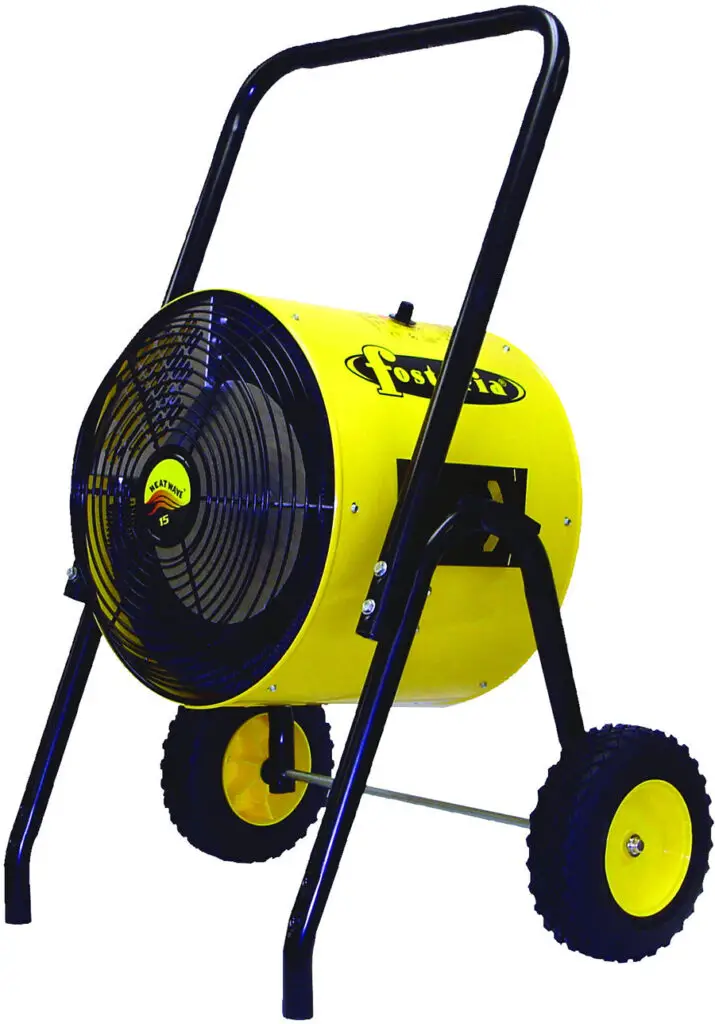This article will provide a good idea of what a bullet heater is, and why it might be useful versus other types of heaters. If you are looking to keep warm on the job site, in the workshop, or under the patio, then its hard to beat a bullet heater. There are three main types of bullet heater we recommend, propane, diesel, and kerosene.
Bullet heaters (often referred to as torpedo heaters) are a portable forced air style of liquid fuel heater.
Bullet heater styling is defined by;
- a cylindrical tube shape,
- an inbuilt fan, and
- it is portable (easily maneuverable).
A bullet heaters shape is characterized by a long thin cylinder. Although designs vary slightly they usually incorporate a stand (sometimes with wheels), and often a fuel tank depending on the fuel type.

Bullet or torpedo heaters should not be confused with salamander heaters. Salamander heaters are a similar style, being cylindrical and forced air, however the cylinder diameter to length ratio is much larger.
Additionally where bullet heaters are typically fuel powered, a salamander heater is often (but not always) an electric heater.
Benefits of bullet heaters
Quick to heat air. Because they are a liquid fuel the heat is created instantly. The heat is then blown in the desired direction by the fan. The immediate direction the hot air is blown towards is warmed instantly.
Heat is directed. Unlike wood heaters which rely on the natural movement of air within a room, and radiate heat in all directions. Bullet heaters send hot air in a controlled direction. This can be beneficial if placing the bullet heater in a corner or against a wall. The heat will be sent into the area that people are occupying.
Price. Bullet heaters are very economical to purchase. They may be somewhat expensive to run depending on fuel type.
Mobility. Bullet heaters are small and lightweight, and usually have wheels built into their frame for ease or portability. They can easily be maneuvered around a room, or transported from one site to another.
Heats outdoor areas. Bullet heaters are designed to be used outdoors. Propane and diesel fueled heaters (such as bullet heaters) are best used outdoors in well ventilated areas. Usually heating an outdoor area is easy to place a bullet heater in a corner of an outdoor area and direct the heat towards where people are congregating. The force provided by the internal fan is designed to throw the heat some distance, providing a directional heating area.
Good for work areas, well ventilated workshops and garages. Just as bullet heaters are good for outdoors, that are equally good for well ventilated workshops and garages. Just be careful to ensure no flammable materials are stored too close. And always ensure there is good ventilation for propane or diesel fueled models.
Adaptable and easily available fuel. Bullet heaters powered by diesel or propane are very convenient. Both these fuels are readily available, and used by multiple devices. An LPG tank is often used for a barbecue grill, so if you unexpectedly run out of LPG, you have a spare bottle ready to go. As with diesel or kerosene, you can fill up a jerry can and continue refueling and heating for as long as you want.
Bullet heaters vs other heater types
When comparing bullet heaters against other types of heaters, you can see there are lots of benefits. Its hard to go past a bullet heater for garage, workshop, or patio heating.
Bullet heater vs Salamander heater
Cost. A bullet heater is typically between 5 to 10 times cheaper than a salamander heater to purchase. For that price difference the bullet heater will be rated at least twice the BTU’s as a salamander heater.
Fuel. A bullet heater comes with its own liquid fuel. A salamander heater requires electrical power, and a lot of it. Many homes will not have the required power outlet suitable to operate a salamander heater. This may require a significant upgrade in electrical wiring.

Fuel. A bullet heater comes with its own liquid fuel. A salamander heater requires electrical power, and a lot of it. Many homes will not have the required power outlet suitable to operate a salamander heater. This may require a significant upgrade in electrical wiring.
BTU’s. A bullet heater can generate a lot of heat. A salamander heater can also generate a lot of heat, but is ultimately limited by how much power is available. A salamander heater just cannot keep up with a bullet heater in terms of heat output. Therefore a bullet heater will easily be able to heat a much larger area than a salamander heater.
A salamander heater is often a good choice for construction work sites that have the required power infrastructure.
Bullet heater vs Wood stove
Cost. A bullet heater is significantly cheaper than the average wood stove, approximately 15 to 20 times cheaper to purchase.
Emissions. A wood stove requires a flue to draw air in, and expel smoke and other emissions. A bullet heater is a clean burning unit that emits heat, it does not create smoke, and therefore does not need a flue or chimney.
Portability. Bullet heaters are small and lightweight, in short they are designed to be portable. Wood stoves are installed in a set location, aka not portable.
Refueling. Bullet heaters will usually run all day without refueling, set and forget. A wood stove needs more wood to be added frequently as the fire wood burns down.
Time to heat. A bullet stove creates heat instantly, as soon as it is ignited. A wood stove may take some time for a fire to get going, then it has to actually heat up, that can take up to an hour or more.
Bullet heater vs Infrared heater
Cost. Bullet heaters and infrared heaters cost a similar amount.
Refueling. Bullet heaters need to be refueled, infrared heaters do not need fuel.
Portability. Both heater types are portable. Some models on infrared heaters can be permanetly installed.
BTU’s. The main difference between bullet heaters and infrared heaters is the heat output. A bullet heater will typically generate a significant amount more heat than a infrared heater.
Heating area. A bullet heater will heat a much larger area than an infrared heater.
Bullet heaters are louder. A bullet heater will make a lot more noise than an infrared heater. This is due to the burning of the gas creating a flame.
If trying to heat a small area, a infrared heater might be the best option. If its a larger open area like a workshop or construction site, then the bullet is probably the better option.
Precautions for using a bullet heater
Carbon monoxide. Bullet heaters use a liquid fuel, usually propane or LPG. Both these fuel types produce carbon monoxide as a by-product. Therefore bullet heaters should only be used in well ventilated areas.
Proximity to flammable materials. Bullet heaters generate an immense amount of heat that is concentrated in a single direction. Make sure when setting up a bullet heater that it is not too close to anything than can melt or catch fire.
Propane safety. Propane can leak if the hose and fittings are damaged or not secured properly. Always test and inspect hose and fittings prior to using a propane bullet heater. To check for leak spray soapy water over the hose and fittings, if you see bubbles forming this indicates a leak.

